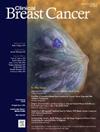动态增强MRI对er阳性、her2阴性乳腺癌的计算机辅助诊断:与Oncotype DX复发评分的关联
IF 2.5
3区 医学
Q2 ONCOLOGY
引用次数: 0
摘要
目的:探讨在接受Oncotype DX检测的er阳性、her2阴性侵袭性乳腺癌患者中,计算机辅助诊断(CAD)得出的动力学特征及其在动态增强MRI上的异质性是否与乳腺癌复发风险相关。方法:我们回顾性评估了227名新诊断为er阳性、her2阴性乳腺癌的女性(平均年龄53岁),这些女性在2018年至2022年期间接受了术前MRI和Oncotype DX检测。增强动力参数及其动态异质性对于每个乳腺癌评估使用CAD系统和相关Oncotype DX RS.Results: 227年的癌症,61年(26.9%)低(< 11),141(62.1%)中级(11-25)和25(11.0%)高(≥26)RS。高危人群(RS≥26)明显高于意味着Angio体积和动态异构CAD相比nonhigh-risk组(RS < 26)(2.52立方厘米和1.42立方厘米,P = 0;.78 vs. 62, P = .025)。多因素回归分析显示,动力学异质性较高(比值比[OR] 12.57, P = 0.024),组织学分级高(3级;OR 21.30, P< 0.001)、孕酮受体阴性(OR 21.30, P = 0.005)和Ki-67较高(≥25%;OR 21.30, P= 0.006)与复发高风险相关。结论:在er阳性、her2阴性乳腺癌患者中,CAD较高的动力学异质性与复发风险增加有关。本文章由计算机程序翻译,如有差异,请以英文原文为准。
Computer-Aided Diagnosis of ER-positive, HER2-Negative Breast Cancer on Dynamic Contrast-Enhanced MRI: Associations With Oncotype DX Recurrence Scores
Purpose
To investigate whether kinetic features derived from computer-aided diagnosis (CAD) and their heterogeneity at dynamic contrast-enhanced MRI are associated with the risk of breast cancer recurrence in patients with ER-positive, HER2-negative invasive breast cancer who have undergone the Oncotype DX assay.
Methods
We retrospectively evaluated 227 women (mean age, 53 years) with newly diagnosed ER-positive, HER2-negative breast cancer who had undergone preoperative MRI and the Oncotype DX assay between 2018 and 2022. The enhancement kinetic parameters and their kinetic heterogeneity for each breast cancer were assessed using a CAD system and correlated with the Oncotype DX RS.
Results
Of the 227 cancers, 61 (26.9%) had low (< 11), 141 (62.1%) had intermediate (11-25), and 25 (11.0%) had high (≥ 26) RS. The high-risk group (RS ≥ 26) had significantly higher mean Angio volume and kinetic heterogeneity on CAD compared to the nonhigh-risk group (RS < 26) (2.52 cm3 vs. 1.42 cm3, P = .023; .78 vs. .62, P = .025). Multivariate regression showed that higher kinetic heterogeneity (odds ratio [OR] 12.57, P = .024), high histologic grade (grade 3; OR 21.30, P < .001), progesterone receptor negativity (OR 21.30, P = .005) and higher Ki-67 (≥ 25%; OR 21.30, P = .006) were associated with a high-risk of recurrence.
Conclusion
Higher kinetic heterogeneity on CAD was associated with an increased risk of recurrence in patients with ER-positive, HER2-negative breast cancer.
求助全文
通过发布文献求助,成功后即可免费获取论文全文。
去求助
来源期刊

Clinical breast cancer
医学-肿瘤学
CiteScore
5.40
自引率
3.20%
发文量
174
审稿时长
48 days
期刊介绍:
Clinical Breast Cancer is a peer-reviewed bimonthly journal that publishes original articles describing various aspects of clinical and translational research of breast cancer. Clinical Breast Cancer is devoted to articles on detection, diagnosis, prevention, and treatment of breast cancer. The main emphasis is on recent scientific developments in all areas related to breast cancer. Specific areas of interest include clinical research reports from various therapeutic modalities, cancer genetics, drug sensitivity and resistance, novel imaging, tumor genomics, biomarkers, and chemoprevention strategies.
 求助内容:
求助内容: 应助结果提醒方式:
应助结果提醒方式:


